Tanzanian safari: Tent camp on the Serengeti, crocodiles, and soaring over volcanoes
We made several more game drives while visiting the western corridor of Serengeti National Park (June 2007), seeing many, many elephants — and I took so many photos of them that my family got elephant-fatigue when viewing them later.
I’ll only show you a few, and not necessarily the best composed images but the ones showing interesting behavior of these magnificent animals.
Elephants live in extended family groups led by the oldest and largest female and including mothers, daughters, sisters, aunts, and their young. When male elephants mature, they leave the herd to live alone or within a group of bachelors, meeting up with matriarchal herds only to mate.
One day we visited a scrubby area near the Grumeti River and saw a lot of frisky elephants. Believe it or not, we even saw elephants mating, although this pair was discreet enough to have their tryst in the woods.
Nearby, bull elephants were play-fighting.
They pushed and shoved with their heads and trunks, flapping their ears out at each other…
…twisting their trunks around each other.
At one point two bulls became more agitated, and a herd nearby grew anxious. The cows closed ranks, putting the calves inside the circle and facing outward themselves — circling the wagons, so to speak. They were prepared for danger, but after a little while they felt safe enough to continue browsing.
A calf and an older sibling nursing
The Grumeti River runs through the western and much less-touristed portion of Serengeti National Park — a river famous for its massive crocodiles waiting to catch wildebeest on their annual migration. We stopped a few times along the banks to watch hippos and crocodiles in the water and herds nervously coming to drink.
Crocodile swimming our way
Hamerkop, a wading bird that feeds on fish, shrimp, and insects
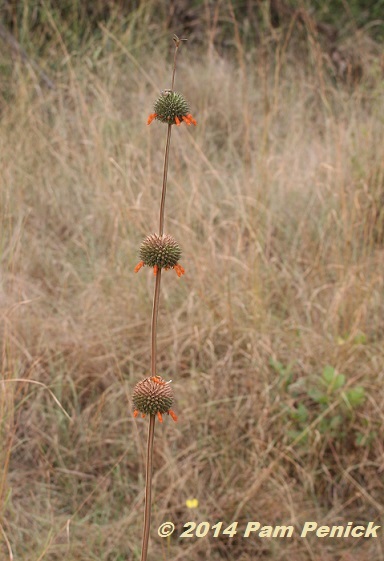
Lion’s tail, a native African plant I’ve grown in my Austin garden. When I saw it I excitedly called out, “Lion’s tail!” — prompting my fellow travelers to look around for the lion I’d spotted.

Bones were everywhere on the Serengeti. When we got out of the balloon the previous day, I noticed bones crunching beneath my feet in the grass. Nature, red in tooth and claw and all that.
One afternoon our guide invited us to cross a swinging pedestrian bridge that spans the Grumeti. One of our drivers went across first, to “test it out.” Check out the big croc lying on the riverbank below.
It looked large enough to eat a man whole.
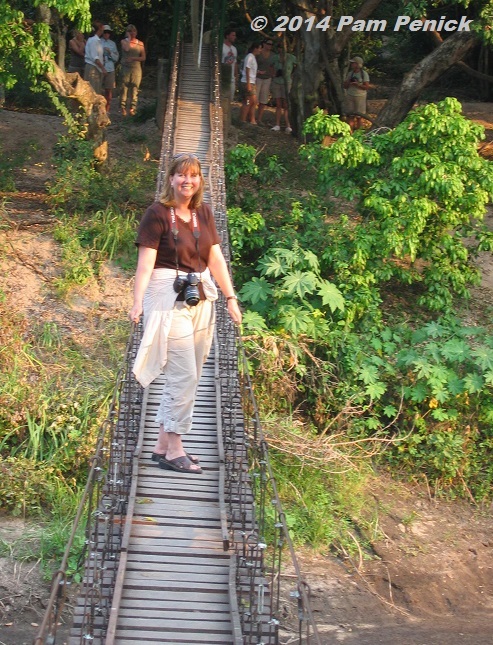
Of course I had to go across. It was more nerve-wracking than I thought it would be, as the bridge swung with the motion of your stride, and the wooden planks seemed designed to trip you. The wire handrails were too low for comfort.
My dad scooted across in his flip-flops, stopping in the middle to take pics of the crocodile.
Not everyone crossed, although most of the group did — one at a time, as the guides requested. As soon as we got across, one of the drivers told everyone to be quiet, and he moved toward the shrubs and trees that lined the top of the bank. We heard some faint noises but did not recognize them. He turned back to us and told the tour leader that an elephant was nearby, and they hustled us all back up on the bridge platform and told us to go back across — immediately, and not one-by-one but a few paces apart. We were a bit anxious as we queued up to cross, looking back over our shoulders — would the elephant come after us? would the bridge hold us? — but we all made it back across on a much bouncier return walk and laughed with relief on the other side.
As we headed back to camp in the late afternoon, we spotted giraffes.
Even some baby giraffes
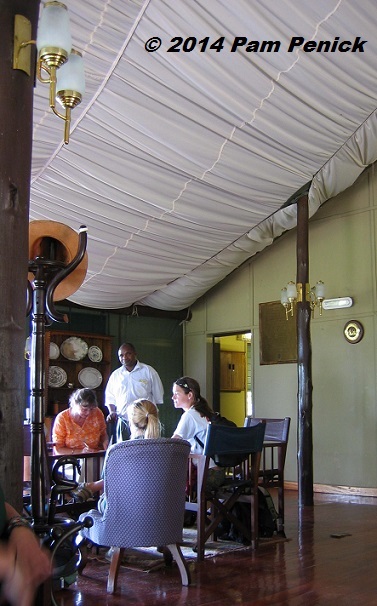
Our lodging here, Kirawira Serena Tented Camp, was straight out of Out of Africa, with cushy sofas and armchairs in English floral fabric, brass-and-frosted-glass lamps mounted onto tent posts, and gleaming hardwood floors. This was a 5-star luxurious tented camp with only 25 “rooms” (tents) plus a tented lobby, lounge, and dining room (and even a swimming pool) in the middle of a very remote location. We hadn’t been on a paved road for days. And yet it was by far the most luxurious lodging of the trip, with the best meals.
Tents were built on stone foundations on a sloping hillside overlooking an expansive savanna.
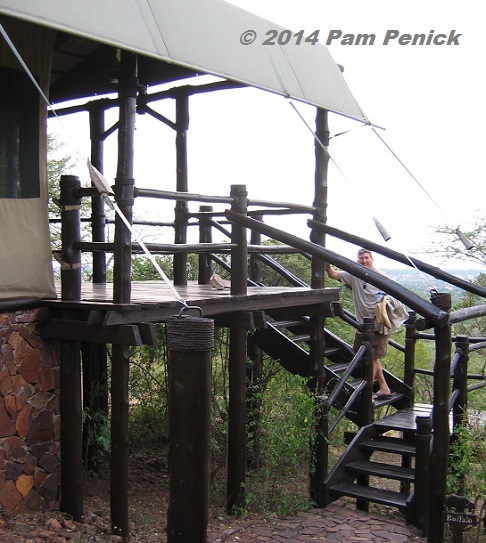
Ours had an elevated front porch, furnished with camp chairs and a table.
It offered an unobstructed view for miles.
Inside, behind a zippered front door — amazing. Not like any tent I’d ever camped in!
Two beds with white, lacy curtains and homey patchwork quilts, plus a writing desk and chair (not visible)…
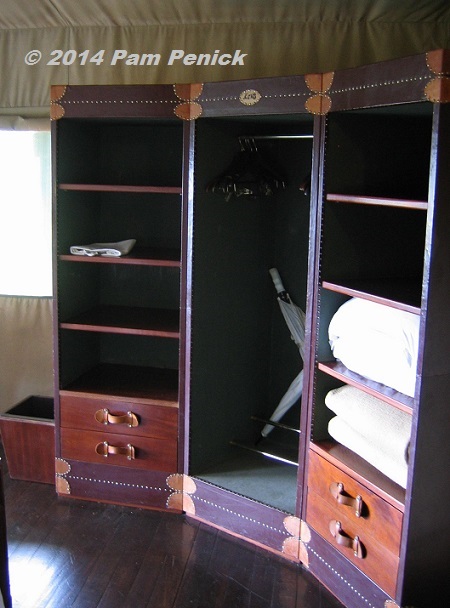
…a steamer-trunk closet…
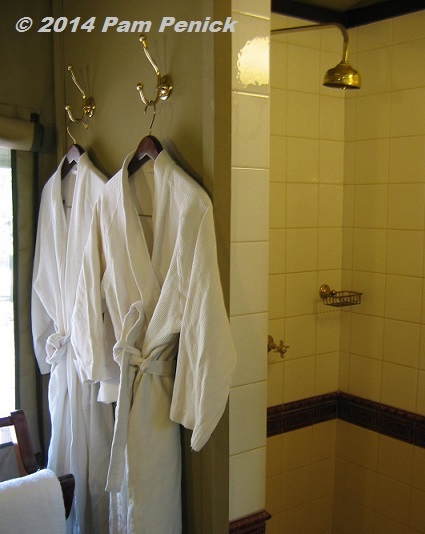
…a small but luxurious bathroom…
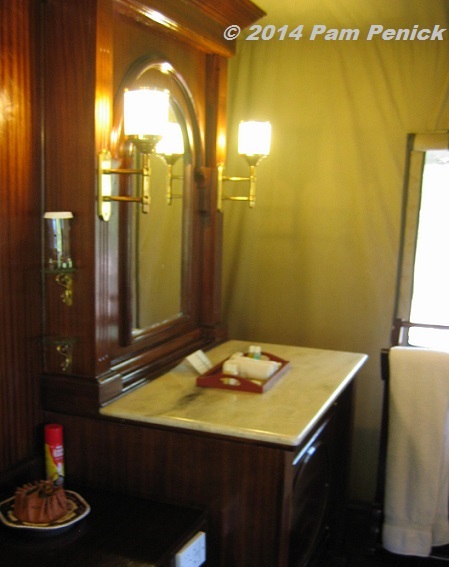
…and mahogany vanities with porcelain sinks and elegant brass hardware. In a tent! I heard from our tour companions that they heard lions roaring at night, but I’ve always been a good sleeper and so unfortunately I did not hear them.
But we did see them on game drives. Here’s a playful older cub with his pride.
He’s almost outgrown his spots.
This pride was led by two males — brothers, we were told. Here’s one, just leaving a recent kill.
And here’s the other, with a limp that the guides noticed and pointed out. He seemed to have been recently injured.
Nearby, we found the kill, a wildebeest, with Marabou storks and vultures cleaning up the remains.
In the Grumeti, hippos lounged mostly submerged, some with only their eyes above the water.

Another new-to-me bird, an insect-eating hoopoe
Wildebeests were abundant.

And we saw a few more giraffes, including this one caught in the act of shaking a bird off its long neck.
And this one doing an awkward A-frame with its legs in order to drink from a stream.
On the banks of the river, more crocs
They were very large. (If you’re interested in comparing African crocodiles with American alligators, see my post about ‘gators in the Everglades.)
The hippos seemed unconcerned with the crocodiles.
We saw many more elephants on the game drive that day, including this cute calf with the very beginnings of tusks.
And this elephant, which was running toward us for a few moments.
More sparring bulls, although the one on the right couldn’t be bothered to put down his mouthful of shrubbery.

The bulls were feisty this day, and at one point our driver surprised two sparring bulls. They didn’t see us until we came around some trees. They broke apart, and the closer one immediately reacted to our presence. He turned his head toward us…
…flared his ears in warning, making him seem even more enormous…
…and trumpeted a ringing blast at us. We were standing up in our seats as usual, so this was delivered at face level, and one of our car-mates dropped into her seat like she’d been shot. It was, perhaps, all for show, but our driver hit the gas, and off we drove, laughing like hyenas.
Our final dinner, served on blue-and-white china in the dining tent…
…with a hungry genet cat (I’d never even heard of this creature) standing hopefully in the shadows.
Early the next morning we took cars to an open, level place where two bush planes awaited. The sunrise was lovely.
We’d driven more than 300 miles on dusty dirt roads to get to Kirawira, but we were to fly back to Arusha in twin-engine planes.
We’d been instructed to use a special Tauck duffel bag, with a weight limit of 33 pounds, while on safari in the Serengeti because our bush planes could only carry so much. The rest of our luggage went back earlier with a supply car.
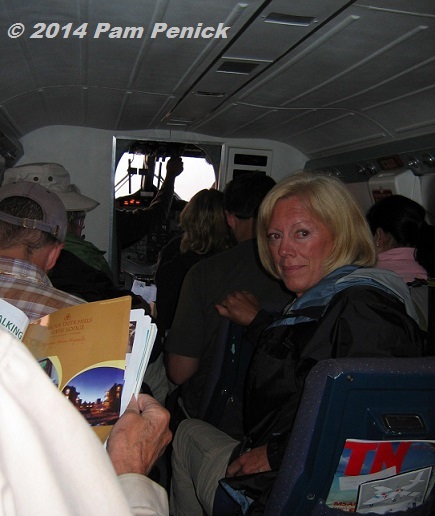
We squeezed in.
After a little while in the air, our pilot told us he had a surprise for us. I don’t normally care for surprises when flying, much less while flying in a tiny plane, but this really was amazing. The pilot flew us over an active volcano!
Ol Doinyo Lengai erupted later that year, in September 2007, but in the 60 seconds or so that we got to peer inside the cone we saw white carbonatite formations…
…and venting cones. Astonishing!
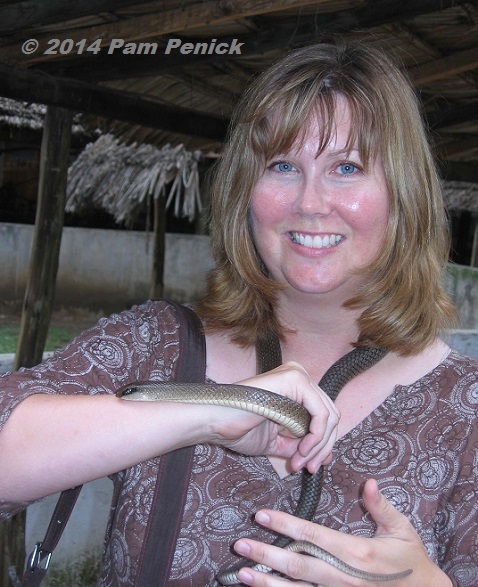
We had a little time to kill before our flight from Arusha that evening, so our guides took us to a museum and gift shop of African art and — yes — a snake farm! I’ve no idea what kind of snake I’m wearing.
As we headed to the airport and said farewell to Tanzania, we caught a hazy glimpse of iconic Mount Kilimanjaro, the perfect ending to our trip.
This concludes my Tanzanian safari series. For a look back at my post about our hot-air balloon ride and game drives on the Serengeti, click here. Follow the links at the end of each post to read them all.
All material © 2006-2014 by Pam Penick for Digging. Unauthorized reproduction prohibited.





















































Wow…what an amazing trip. The photography of the elephants is absolutley amazing!!! Thank you for sharing your experiences.
And thank YOU for patiently wading through them, Lee. 😉 —Pam
Oh, Pam… I am so green with envy. I thought the wildlife in Yellowstone and the Tetons were awesome, but I think I’d cry at the beginning and end of every day if I were in Africa. What an amazing trip! Thank you so much for sharing this with your readers.
Patty, I’m so glad to know you enjoyed the series. I’ve been to Yellowstone too and LOVED the wildlife-viewing there as well. They don’t call it the Serengeti of North America for nothing. —Pam
I love that you posted a couple of bird photos. What luxury out in the middle of nowhere. What a trip.
Lisa, our guides told us many people come out on safari just for the bird watching. I can believe it. It’s not just about the big animals! —Pam
All I can say is WOW! What a magnificent adventure you had! BTW, snakes are the new in accessory this year soon to be seen on runways and red carpets all over the world. You are such a trend setter!
Ha ha! Well, you know, their skin really does feel quite nice. —Pam
Where do I start? The volcano is so cool. And that river area looks like it was really neat. And the ellies (as I call them)! I watched a video that a friend of mine took where an elephant chased their jeep for a long while. It was funny and scary at the same time. So you’re lucky you only got the ear flapping! I love that view you had from your tent. I wish I had taken more pics of the tents and planes but I think I was in another world after a while. I so enjoyed your posts, Pam. Thanks for doing them.
It truly did feel like another world at times. There are many things I wish I’d done more of while I was there — sit on the porch and just look at the view, stay up late and listen to wildlife noises, talk more with locals — but I am happy with the things I did do. There’s always a reason to go back, right? —Pam
Thank you so much for sharing this series of posts. I have really enjoyed them.
It was my pleasure, Les! —Pam
What a fascinating trip of a lifetime! I was curious about the volcano crater a couple of posts back. Is that a semi closed ecosystem or do most of the animals come and go from the crater?
You’re referring to Ngorongoro Crater, I think? I remember our guides telling us that most of the animals stay within the crater. Checking Wikipedia, though, I read this: “Although thought of as ‘a natural enclosure’ for a very wide variety of wildlife, 20 percent or more of the wildebeest and half the zebra populations vacate the crater in the wet season. Buffalo…and eland do the opposite. Their highest numbers are during the rains.”
However, there’s also this: “The crater has one of the densest known population of lions, numbering 62 in 2001. A side effect of the crater being a natural enclosure is that the lion population is significantly inbred. This is due to the very small amount of new bloodlines that enter the local gene pool, as very few migrating male lions enter the crater from the outside. Those who do enter the crater are often prevented from contributing to the gene pool by the crater’s male lions, who expel any outside competitors.” http://en.wikipedia.org/wiki/Ngorongoro_Conservation_Area
—Pam
Amazing trip Pam! I enjoyed learning about your wonderful experiences in the series. So glad you found an opportunity to share this on Digging.
Thanks for your comment, Shirley. I’m so glad you enjoyed it. —Pam